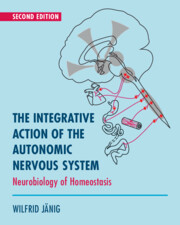Book contents
- The Integrative Action of the Autonomic Nervous System
- Reviews
- The Integrative Action of the Autonomic Nervous System
- Copyright page
- Dedication
- Contents
- Foreword to the Second Edition
- Foreword to the First Edition
- Preface
- Abbreviations
- Introduction The Autonomic Nervous System and the Regulation of Body Functions
- Part I The Autonomic Nervous System: Functional Anatomy and Interoceptive Afferents
- Part II Functional Organization of the Peripheral Autonomic Nervous System
- Part III Transmission of Signals in the Peripheral Autonomic Nervous System
- Part IV Representation of the Autonomic Nervous System in the Spinal Cord and Lower Brain Stem
- Part V The Centers of Homeostasis in the Mesencephalon and Hypothalamus and Their Telencephalic Control
- Chapter 11 Integration of Autonomic Regulation in the Upper Brain Stem and Limbic–Hypothalamic Centers: A Summary
- Epilogue The Autonomic Nervous System in Future Research: Some Personal Views
- Index
- References
Chapter 11 - Integration of Autonomic Regulation in the Upper Brain Stem and Limbic–Hypothalamic Centers: A Summary
from Part V - The Centers of Homeostasis in the Mesencephalon and Hypothalamus and Their Telencephalic Control
Published online by Cambridge University Press: 16 July 2022
- The Integrative Action of the Autonomic Nervous System
- Reviews
- The Integrative Action of the Autonomic Nervous System
- Copyright page
- Dedication
- Contents
- Foreword to the Second Edition
- Foreword to the First Edition
- Preface
- Abbreviations
- Introduction The Autonomic Nervous System and the Regulation of Body Functions
- Part I The Autonomic Nervous System: Functional Anatomy and Interoceptive Afferents
- Part II Functional Organization of the Peripheral Autonomic Nervous System
- Part III Transmission of Signals in the Peripheral Autonomic Nervous System
- Part IV Representation of the Autonomic Nervous System in the Spinal Cord and Lower Brain Stem
- Part V The Centers of Homeostasis in the Mesencephalon and Hypothalamus and Their Telencephalic Control
- Chapter 11 Integration of Autonomic Regulation in the Upper Brain Stem and Limbic–Hypothalamic Centers: A Summary
- Epilogue The Autonomic Nervous System in Future Research: Some Personal Views
- Index
- References
Summary
Upper brain stem, hypothalamus and cerebral hemispheres contain the representations of elementary motivational behaviors. These representations receive multiple afferent feedback and are responsible for the integration of regulation of autonomic, neuroendocrine and somatomotor systems. The dorsolateral, lateral and ventrolateral cell columns in the periaqueductal gray of the mesencephalon contain the neural circuits representing the autonomic and somatomotor components of the defense behaviors, confrontation, flight and quiescence. These circuits are quickly activated by the cortex during dangerous situations and represent the basic neural machinery for active and passive coping. Coordinated autonomic responses are quickly generated by signals from the telencephalon during diving, freezing, tonic immobility, exercise, etc. These autonomic responses occur in anticipation of the somatomotor responses demonstrating that the cortical signals have direct access to the autonomic centers. The basic emotions in humans are accompanied by autonomically mediated response patterns characteristic for each emotion. The hypothalamus contains the neural structures that integrate and coordinate autonomic, neuroendocrine and somatomotor responses to basic behaviors such as defensive, reproductive, nutritive, drinking, thermoregulation and sleep-waking behavior.
Keywords
- Type
- Chapter
- Information
- The Integrative Action of the Autonomic Nervous SystemNeurobiology of Homeostasis, pp. 355 - 396Publisher: Cambridge University PressPrint publication year: 2022

